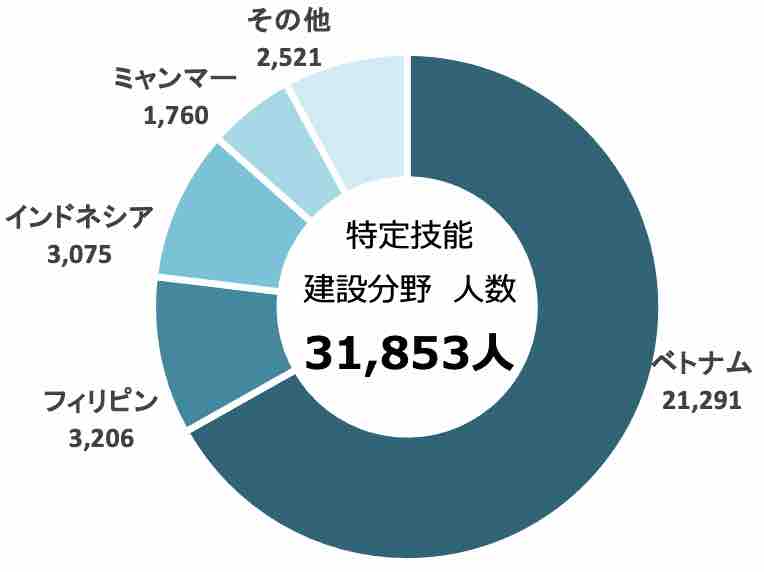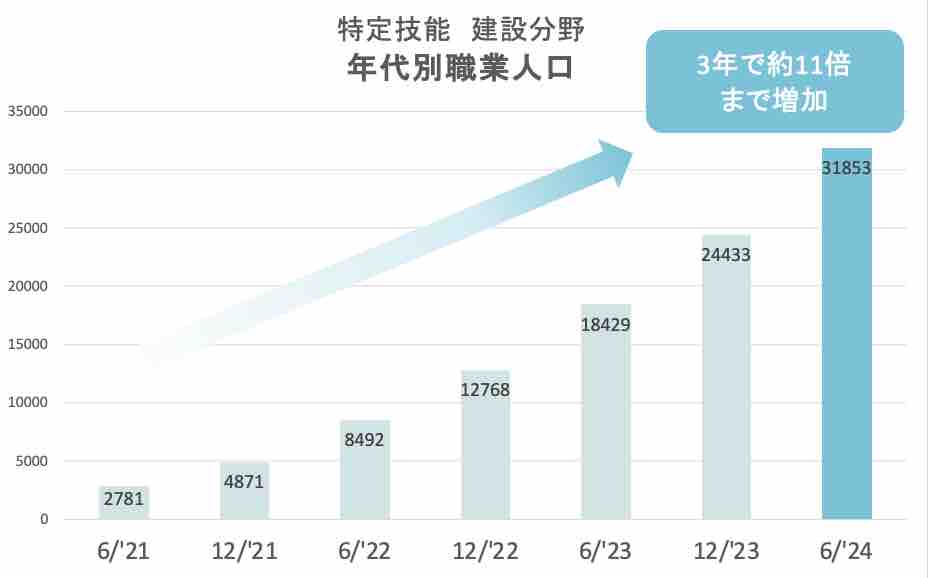Job Introduction - Construction industry
This page provides information to help with career choices, such as types of jobs in construction, their annual income, current worker numbers, and job descriptions.
Index
- 1. What is SSW in Construction?
- 2. Job details
- 3. Required Exams and Qualifications
1. What is SSW in the Accommodation Industry?
1-1 Background
The construction industry is facing a severe labor shortage due to factors such as the declining birthrate, young people moving away from cars, and the diversification of career choices. As the average age of construction workers rises, it has become difficult to secure enough domestic talent. In response to this situation, a system was introduced to accept foreign workers.
1-2 Population and Current Status
The Immigration Services Agency aggregates and publishes the number of people working under the SSW qualification every six months (previously every three months until 2022). According to the data, the population ratio by country or age is as follows.

As of the end of June 2024, there are 31,853 people working in the SSW construction industry. Most of the workers are from Asia, with Vietnam, the Philippines, Indonesia, and Myanmar being the top countries of origin.

Although the SSW system began in 2019, the population of workers in construction has increased approximately elevenfold over the past three years, and the number is expected to continue expanding.
source : 出入国在留管理庁(https://www.moj.go.jp/isa/applications/ssw/zairyuarchive.html)
There are two systems for accepting foreign workers: the Technical Intern Training Program and the SSW Program, but their purposes and characteristics are quite different.
The Technical Intern Training Program aims to equip young people from developing countries with Japanese technical skills, enabling them to contribute to their home countries' development after returning. The main purpose is skill acquisition, and it is positioned as training rather than labor. Therefore, job changes are not allowed, and the maximum duration is five years.
On the other hand, the SSW Program was established to supplement Japan's labor shortage. There are two types, SSW 1 and SSW 2, which accept foreign workers as immediate assets. Job changes are allowed, and in SSW 2, it is possible to bring family members and even apply for permanent residency. A test to prove skills and Japanese language ability is required, and workers with practical experience are preferred.
In addition, foreign workers who have completed the Technical Intern Training Program can transition to the SSW Program. Experience gained through technical training is recognized, and part of the SSW 1 test is exempted, making the transition relatively smooth. This allows foreign workers to continue working in Japan for a longer period after completing their internships, with opportunities for job changes and career advancement.
2. About Jobs and Duties in the Accommodation Industry
2-1 2-1 Job Description
In the construction field, workers can mainly take on three roles: Civil Engineering, Architecture, and Lifeline/Facilities.
Civil Engineering
- Tasks include formwork construction, concrete pumping, tunnel boring, construction machinery operation, earthworks, rebar construction, scaffolding, marine civil engineering, etc.
- Under the guidance and supervision of a manager, workers engage in the construction, renovation, maintenance, and repair of civil engineering facilities.
- Procurement and transportation of raw materials and parts, maintenance and management of equipment, devices, and tools
- Preparatory tasks such as assembling scaffolding and digging up equipment, cleanup tasks such as dismantling scaffolding and backfilling equipment
- Cleaning, maintenance, and other related tasks
Architecture
- Work related to the construction, expansion, renovation, relocation, repair, and remodeling of buildings
- Work such as formwork construction, plastering, concrete pumping, roofing, earthworks, rebar construction, rebar splicing, interior finishing, wall covering, scaffolding, carpentry, sheet metal work, spray polyurethane insulation, etc.
- Procurement and transportation of raw materials and parts, maintenance and management of equipment, devices, and tools
- Engaging in preparation tasks such as assembling scaffolding and digging up equipment, and cleanup tasks such as dismantling scaffolding and backfilling equipment
- Cleaning, maintenance management, and other related tasks
Lifeline and equipment
- Work related to the installation, setup, modification, and repair of lifeline equipment such as telecommunications, gas, water supply, and electricity
- Work such as telecommunications, piping, sheet metal work, thermal insulation, etc.
- Procurement and transportation of raw materials and parts, maintenance and management of equipment, devices, and tools
- Preparatory tasks such as assembling scaffolding and digging up equipment, cleanup tasks such as dismantling scaffolding and backfilling equipment
- Cleaning, maintenance management, and other related tasks
Please refer to the following site for detailed job descriptions.
2-2 Average Salary
The average monthly salary for workers in the "Construction" SSW is ¥285,339, which is higher than the average across all fields, ¥231,979. This amount includes overtime and other allowances, and while there may be slight differences depending on the region and company, overall it is a stable source of income. Additionally, companies are required to provide social insurance and welfare benefits for those working in Japan under the SSW, ensuring medical and pension support. Furthermore, construction is a technical profession, offering opportunities for pay raises as you gain experience. Working in the construction sector under SSW offers both skill development and stable income, making it an attractive career choice.
3. Required Exams and Qualifications
To obtain the "Construction" SSW qualification, you must pass both a Japanese language test and a skill test.
3-1 Japanese Language Test
There are two types of Japanese language tests: the Japanese Language Proficiency Test (JLPT) and the Japan Foundation Test for Basic Japanese (JFT-Basic), and you must pass one of them.
The Japanese Language Proficiency Test (JLPT) evaluates the Japanese language ability of non-native speakers. JLPT has five levels (N1, N2, N3, N4, N5), with N1 being the most difficult and N5 being the easiest. To meet the requirements of the SSW test, you must pass N4 or higher. N4 is the level that demonstrates the ability to understand basic Japanese, and it tests whether you can engage in everyday conversations and read simple texts.
- Time: Twice a year (July and December)
- Test Locations: Various countries and regions around the world
- How to Apply: Online or by mail
- Test Method: Mark sheet (on-site)
source : 日本語能力試験 JLPT(https://www.jlpt.jp/index.html)
The Japan Foundation Test for Basic Japanese (JFT-Basic) has six levels (A1, A2, B1, B2, C1, C2), with C2 being the most difficult and A1 being the easiest. To meet the requirements of the SSW test, you must pass A2 or higher. A2 is the level that demonstrates the ability to understand basic Japanese, and it tests whether you can engage in everyday conversations and read simple texts.
- Time: Anytime throughout the year
- Test Locations: Various countries and regions around the world
- How to Apply: Online reservation
- Test Method: CBT (Computer-Based Testing)
source : 国際交流基金日本語基礎テスト JFT-Basic(https://www.jpf.go.jp/jft-basic/)
This site summarizes detailed test structures, sample questions, test information, and strategies for the Japanese Language Proficiency Test (JLPT) and the Japan Foundation Test for Basic Japanese (JFT-Basic).
3-2 3-2 Skill Evaluation Test
The construction SSW exam evaluates the basic knowledge and skills needed to work as a construction worker in Japan. The exam is of intermediate difficulty (equivalent to Grade 3 Skills Test). It is hosted by the Japan Association for Construction Human Resources (JAC) under the guidance of the Ministry of Land, Infrastructure, Transport, and Tourism. There are both written and practical exams, and those who pass can obtain the SSW qualification and work legally in Japan.
- Time: Once per year in January
- Exam Locations: Japan (Tokyo, Osaka, Aichi, Fukuoka, Okayama, etc.)
- How to Apply: Online reservation (through a dedicated app)
- Exam Method: Multiple-choice on a mark sheet
※For detailed test information, please check the Japan Association for Construction Human Resources (JAC) website.
This site provides a summary of detailed exam structures, sample questions, test information, and strategies for the construction SSW exam.